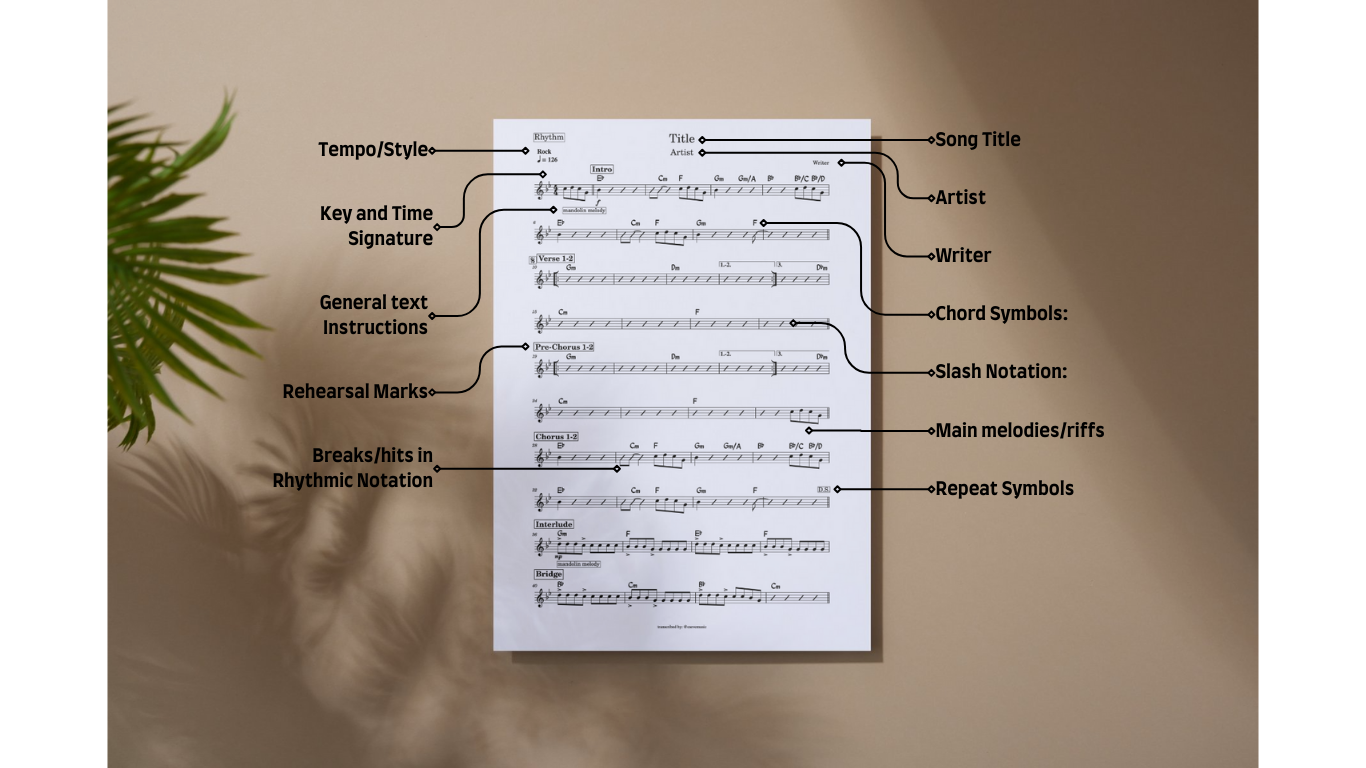Guide
Guide
A Quick guide to Chord Charts
Discover the essential information provided in our charts.
A chord chart is a visual representation of a song used by musicians to play songs on various instruments, especially guitars and keyboards. It provides essential information about the chord changes and the structure of a song. Here’s a quick guide to describe the elements of a chord chart.
A chord chart is a visual guide used by musicians to play songs by showing essential information about chords, rhythm, and structure. Here’s a quick guide to the elements of a chord chart, focusing on common elements used in rhythmic charts:
A chord chart is a visual representation of a song used by musicians to play songs on various instruments, especially guitars and keyboards. It provides essential information about the chord changes and the structure of a song. Here’s a quick guide to describe the elements of a chord chart:
A chord chart is a visual guide used by musicians to play songs by showing essential information about chords, rhythm, and structure. Here’s a quick guide to the elements of a chord chart, focusing on common elements used in rhythmic charts:
- Song Title: The name of the song, usually at the top of the chart.
- Artist: The performer or band for whom the chart is written.
- Writer: The person who composed the song, often listed under or near the title.
- Tempo/Style: Indicates the speed (e.g., ♩ = 120) and the general feel or genre of the song (e.g., “Rock” or “Ballad”).
- Key Signature: Shows the tonal center of the song, which helps determine the chords and notes used.
- Time Signature: Displays the rhythmic structure (e.g., 4/4, 6/8), showing how many beats per measure.
- General Text Instructions: Brief notes or cues that guide the musician on dynamics, articulation, or other performance details (e.g., “Play softly here”).
- Chord Symbols: Letters or symbols (e.g., C, G7, Am) that represent the chords to be played, typically placed above the staff or measures.
- Rehearsal Marks: Labels (e.g., “A,” “B,” “Verse,” “Chorus”) that indicate different sections of the song, helping musicians navigate easily.
- Slash Notation: Slashes that represent beats in a measure, typically used to indicate rhythm without specific note pitches.
- Breaks and Hits in Rhythm Notation: Specific notations for rhythmic hits, stops, or breaks, indicating when to play or pause.
- Main Melodies: Occasionally, charts will include notated melodies or lead lines in staff notation, showing essential parts of the tune.
- Repeat Symbols: Indications like “D.S. al Coda” or repeat bars (||: :||) that instruct the musician to repeat certain sections of the song.
Chord charts are invaluable tools for musicians of all levels, making it easier to learn and play songs. They provide a clear roadmap for chord changes, lyrics, and song structure, allowing musicians to perform with accuracy and confidence.
partitura

Tempo Style
Indicates the speed (e.g., ♩ = 120) and the general feel or genre of the song (e.g., “Rock” or “Ballad”).
Key and Time Signature
Key Signature: Shows the tonal center of the song, which helps determine the chords and notes used.
Time Signature: Displays the rhythmic structure (e.g., 4/4, 6/8), showing how many beats per measure.
General Text Instruction
Brief notes or cues that guide the musician on dynamics, articulation, or other performance details (e.g., “Play softly here”).
Rehearsal Marks
Labels (e.g., “A,” “B,” “Verse,” “Chorus”) that indicate different sections of the song, helping musicians navigate easily.
Breaks and Hits in Rhythm Notation
Specific notations for rhythmic hits, stops, or breaks, indicating when to play or pause.
Song Title
The name of the song, usually at the top of the chart.
Artist
The performer or band for whom the chart is written.
Writer
The person who composed the song, often listed under or near the title.
Chord Symbols
Letters or symbols (e.g., C, G7, Am) that represent the chords to be played, typically placed above the staff or measures.
Slash Notation
Slashes that represent beats in a measure, typically used to indicate rhythm without specific note pitches.
Main Melodies
Occasionally, charts will include notated melodies or lead lines in staff notation, showing essential parts of the tune.
Repeat Symbols
Indications like “D.S. al Coda” or repeat bars (||: :||) that instruct the musician to repeat certain sections of the song.
Chord charts are invaluable tools for musicians of all levels, making it easier to learn and play songs. They provide a clear roadmap for chord changes, lyrics, and song structure, allowing musicians to perform with accuracy and confidence.





